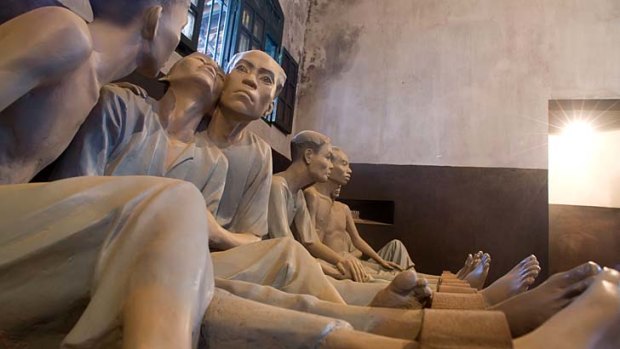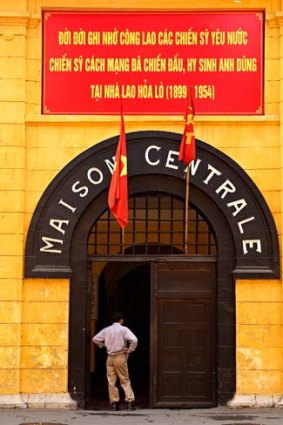This was published 11 years ago
In the shadow of Uncle Ho
Lance Richardson explores a trio of Hanoi museums, where lessons in rhetoric and patriotism are writ large.

Models of prisoners at Hoa Lo.Credit: Alamy
In Hanoi's Revolutionary Museum in the Hoan Kiem District, one cabinet stands out. It contains two objects of note. The first is a blue cap with "Vets for peace in Vietnam" written across the front. This is explained as a "hat worn by Association of American War Veterans ... in favour of Vietnam's Resistance War Against America". The second object is a small padlock, allegedly used to "lock the parliament building by Australian workers".
The cap is a case of selective interpretation, the vets' petition for peace recast as support for what was, at that moment, America's enemy. The padlock is even more suspect. I don't recall a workers' coup in history class. Besides, this lock could barely secure a bicycle, let alone the Australian Parliament's doors.
Hanoi museums are not museums in the traditional sense, which is to say that truth is subordinate to propaganda. If you're searching for a glimpse of communist rhetoric in action, however, there are few better places to begin. The Revolutionary Museum is arranged in a chronological though haphazard fashion, stretching from French colonialism to the formation of the Socialist Republic. There are Trotsky pamphlets and a replica grenade; a map of North Vietnam flashes like a gaudy neon sign. Nearby, a statue of Ho Chi Minh, the father of the revolution, reads the declaration of independence in a diorama of Ba Dinh Square, 1945. Later, there's a portrait of "Uncle Ho" sketched on fine silk - in blood. The museum feels like the photographs in the middle of a history book with the surrounding pages removed. The closer I examine individual items, the more any overarching narrative recedes into fog. A visitor is left with little beyond a single, saturating theme: us versus them; the Vietnamese versus the French and Americans. This is a museum more concerned with encouraging patriotism than historical fact.

Hoa Lo prison in Hanoi.Credit: Alamy
Many travellers will be more familiar with Hoa Lo Prison, which is popularly known as the Hanoi Hilton. Built by the French in 1896 above Phu Khanh village, Hoa Lo has long been viewed by the Vietnamese as a symbol of colonial violence and oppression. Visitors who come to see where many American soldiers were interned during the Vietnam War are first treated to an unexpected prologue.
In a dimly lit room, I find more than 25 emaciated Vietnamese mannequins shackled in two lines. A grandiose shrine upstairs affirms "the revolutionary spirit of communists could not be dampened by savage regulations in the prison given by French colonists". This is in stark contrast with the conditions allegedly afforded American prisoners. "During the war the national economy was difficult but [the] Vietnamese government created the best living conditions [for] US pilots," a plaque claims, positioned near a photograph of prisoners playing football in the courtyard. Vietnamese people were tortured at Hoa Lo by the French. The museum, however, paints a picture of justice and restraint when the Vietnamese assumed control and filled the facility with their new foe, "American imperialists".
My favourite museum looks like a giant lotus flower. The Ho Chi Minh Museum, which has been baffling visitors for years, can be described only as conceptual for its attempt to evoke the chairman's thinking through creative displays. I wander the fixed route, pausing to contemplate a porcelain vase and clothes on a hatstand that represent "the life of feudalists and imperialists and their collusion in Vietnam". Then there is Picasso's Guernica. The painting once inspired Ho, so the curators have re-imagined it in three dimensions.
Next up is Coc Bo Cave, the nerve centre of the revolution, presented as a walk-in brain (Ho's); and symbolic fireworks, "an architectural detail depicting both the atmosphere associated with victory over fascism and mankind's desire for peace". Still to come is a volcano (revolution), a car crashing through the wall (American aggression) and a giant bowl of papier-mache fruit (unknown). Though wildly entertaining, the museum feels, in retrospect, like a warm-up; the strangest exhibition is to come.
To visit the Ho Chi Minh Mausoleum is to be exposed to the full apparatus of communist control and paranoia. It is a lofty stone box, columned beneath a sloping roof, built before 240 green squares representing rice paddies. I get in trouble for walking on the paddies, then in trouble again for walking on the paths around them. My bag is too big, but if I squish it into a ball, the guard will turn a blind eye. Cameras are prohibited. Headphones are prohibited, too. Talking is outlawed and I must not raise my hands above my waist or put them in my pockets.
By the time I reach the mausoleum's inner sanctum, I have more citations than fingers and toes. But there is Ho, lying in a glass coffin, looking less like a person than a Madame Tussauds wax celebrity in khaki. The display is undeniably powerful; I immediately forget my transgressions.
In his will, Ho asked to be cremated and his ashes spread throughout the country. The party ignored him. His body was embalmed and put on display for 10 months a year (October and November are reserved for "maintenance"). It feels appropriate, though. When museums are less about history than affirming loyalty through symbols and the careful arranging of reality, what greater exhibit can there be than the chairman himself?
Lance Richardson travelled courtesy of China Southern Airlines.
FAST FACTS
Getting there
China Southern Airlines has a fare to Vietnam from Sydney and Melbourne for about $1195 low-season return, including tax. Fly to Guangzhou (about 9hr), then to Hanoi (2hr); see flychinasouthern.com. This fare allows you to fly out of Ho Chi Minh City.
Visiting there
Vietnam's Revolutionary Museum, established in 1959, has more than 30 galleries spread across two floors of what was the Trade Department building. Admission is 15,000 dong (68¢). Tran Quang Khai Street, Hanoi.
The Hoa Lo Prison Museum is most famous for housing American prisoners of war, including John McCain, though a guillotine room hints at a darker past. Admission is 10,000 dong; Hoa Lo Street.
The Ho Chi Minh Mausoleum is open every morning, except in October and November. The adjacent Ho Chi Minh Museum is designed to look like a giant lotus, the chairman's favourite flower. Admission is 5000 dong; entry to the mausoleum is free. At Ba Dinh Square.
More information See vietnamtourism.com.
Sign up for the Traveller Deals newsletter
Get exclusive travel deals delivered straight to your inbox. Sign up now.